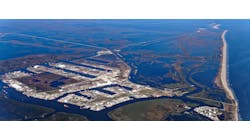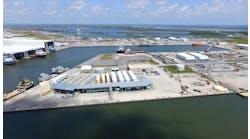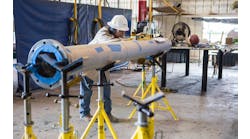It may come as a surprise, but for some Port Fourchon companies one of the hottest markets in the Gulf of Mexico these days has nothing to do with drilling or production. Quite the contrary, actually.
“Salvaging is by far the biggest market in the GoM other than deepwater drilling. The numbers are unbelievable,” says Jimmie “Beau” Martin Jr., sales representative for family-owned B & J Martin Inc., which has a strong focus in post-decommissioning seabed cleaning.
Before dismissing Martin’s assessment as fanciful, consider the results of the Gulf of Mexico Decommissioning Report released in December. According to the report’s author, Dr. Mark J. Kaiser, director of Research and Development at Louisiana State University, GoM decommissioning is destined to be a well over $3 billion market over the next five years. The GoM holds more than 4,000 platforms and Kaiser wrote that an average of 140 structures have been removed annually over the past decade with another 424 wells P&A’d. US Minerals Management Service (MMS) regulation mandates a site be cleared one year after abandonment.
“Throw in the occasional devastating hurricane and the huge impact this has had both in activity volume and cost and you have an annual industry worth between $377 million and $825 million,” Kaiser concludes. “The total exposure for decommissioning in the GoM sits somewhere between $18 billion and $57 billion.”
Martin adds that many operators just now are getting around to permanently abandoning the structures Hurricane Katrina destroyed in 2005, “and then we had (hurricanes) Gustav and Ike.
“Everything really slows down for us right after a hurricane, because operators’ priorities are trying to restore what production they can. They worry about abandonment later,” he says.
While his family’s 63-year-old Port Fourchon company also operates Martin Quarters, which manufacturers rig and platform office and housing modules, Martin says that for the past two decades much of the firm’s attention has focused on ensuring the seabed is cleared once the topsides have been removed for platform decommissioning. The foundation of the Martin seabed clearance business is its patented Gorilla Net, which is constructed of a weave of 9/16-in. combination cable at the opening and a body made with twine five times the strength of a standard trawl net. Martin says the increased strength allows it to contain debris that would rip a standard net.
He says as the net is pulled across the seabed it can clear several tons of debris within an 80-ft (24-m) pass, with the activities on each line recorded electronically. Once the debris is removed, the Gorilla is followed by a verification pass to confirm to operators and regulatory authorities that the site, indeed, is clear.
“With the Gorilla, we are able to remove seabed debris for 20% of the costs of using divers or some other clearing method. We also can do in two days what normally would take a month,” he says.
The trawlers that pull the net have a remarkable resemblance to standard shrimp boats, which Martin’s grandfather Beauregard Martin of Galliano, Louisiana, operated from 1947 until the company he founded turned its sights toward servicing the oil and gas industry 20 years later. With the commissioning of a 110-ft (34-m) trawler in December 2009, the company now has five vessels, all of which are at work with their six-man crew, says Martin. The largest vessels can operate in a maximum 400-ft (122-m) water depth.
Martin emphasizes that the nets are constructed to allow fish and other aquatic life to escape unharmed.
“We’re here to pick up debris, not catch fish,” he says.
The company has serviced the oil and gas industry since 1968, but it was not until 1990 that Martin entered the seabed clearance business. Since then, Beau Martin estimates the company has cleared between 600 and 700 locations.
“The operators have done a tremendous job of returning the seabed to its natural state. Once they have borrowed it, the oil companies return the seabed to as good or better condition than it was when they got it,” he says.
Mountains of Gorilla Nets are on standby at the B & J Martin Inc. facility in Port Fourchon.




